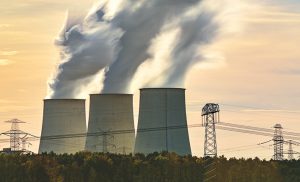BLOOMBERG
Germany has set aside more than €260 billion ($275 billion) to deal with the immediate risks of an energy crisis triggered by Russia’s war in Ukraine, but the ultimate fix will be much costlier — if the country can pull it off at all.
The pending price tag for future-proofing the country’s energy system is projected to amount to over $1 trillion by 2030, according to BloombergNEF.
The costs include investments in upgrading power grids and above all new generation to manage the phase out of nuclear and coal plants, handle increased demand from electric cars and heating systems, and meet climate commitments.
The transition will require the installation of solar panels covering the equivalent of 43 soccer fields and 1,600 heat pumps every day. It also needs 27 new onshore and four offshore wind plants to be built per week, according to a wish list presented by Chancellor Olaf Scholz during a recent visit to Volkswagen AG’s headquarters in Wolfsburg.
“This is a bold undertaking — possibly the boldest project since the reconstruction of Germany,†Vice Chancellor Robert Habeck, who oversees climate and energy policy, said earlier this month.
Around 250 gigawatts of new capacity will have to be installed by 2030 — when power demand is expected to be about a third higher than it is now — according to estimates from Germany’s network regulator and think tank Agora Energiewende.
To put the scale of the challenge in context, the required generation is enough to cover current household demand for all 448 million people in the European Union. The additions will be a mix of renewables and gas-fired plants — that might one day be converted to run on hydrogen.
It will be a long road to get there. The government announced it will prepare tenders this year for gas plants that account for about a tenth of that capacity. And for renewable expansion, setting up a single wind mast can takes as long as seven years to clear Germany’s red tape.
BASF SE’s plans to cut 2,600 jobs as it faces strains from the energy crisis is a sign of the urgency. The chemical giant’s operations in Germany swung to a loss during the second half, and it’s now closing a number of energy-intensive factories, including two ammonia plants and related fertiliser facilities, resulting in 700 job cuts at its main Ludwigshafen site.
“High energy prices are now putting an additional burden on profitability and competitiveness in Europe,†Chief Executive Officer Martin Brudermueller said. He also cited “overregulation, slow and bureaucratic permitting processes.â€
At the heart of Germany’s dilemma lies political plans to phase out certain energy sources without clearly setting out the path to replace them. The country’s last three nuclear power plants will shut by mid-April, and it now aims to accelerate its exit from coal to 2030. The challenge has been intensified after Russia — Germany’s main energy supplier before the war — curtailed gas flows.
With nuclear and coal off the table, Germany has undertaken a rapid rollout of terminals for importing more expensive liquefied natural gas (LNG) as it seeks to ensure it has the energy to power its industry-heavy economy. At the same time, electric cars, heat pumps and electrolysers for producing hydrogen are set to raise demand by 33% to around 750 terawatt-hours by 2030, according to government estimates.
While Scholz and Habeck have shown there’s political will to push ahead with the transition, they need help from the private sector, including sourcing the tons of steel and other materials required for such a massive undertaking, according to Lisa Fischer, an energy-systems expert at think tank E3G.
Germany also needs to figure out how it will generate electricity when wind and sun aren’t available. The government’s plan so far involves readying a fleet of new gas plants that can later run on hydrogen, though it’s struggling to find investors willing to take on such costly projects.
 The Gulf Time Newspaper One of the finest business newspapers in the UAE brought to you by our professional writers and editors.
The Gulf Time Newspaper One of the finest business newspapers in the UAE brought to you by our professional writers and editors.
